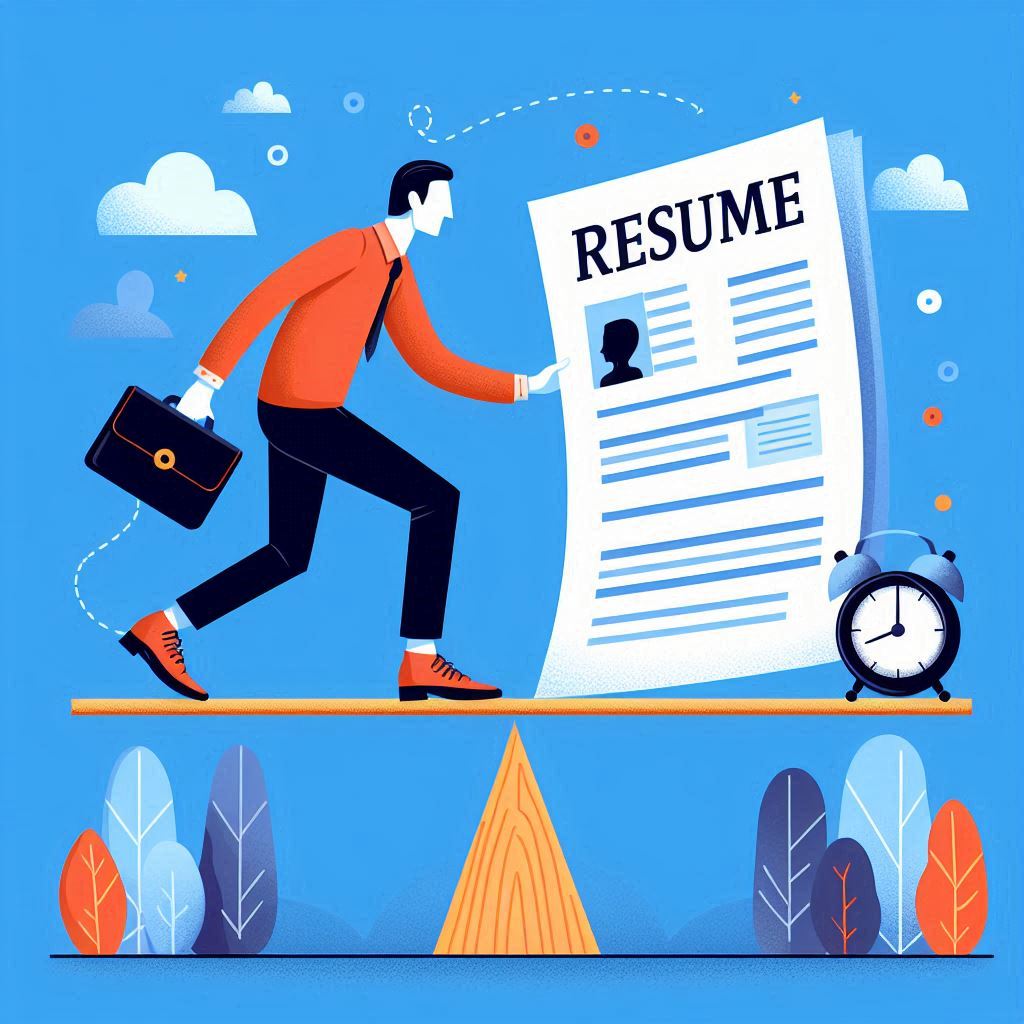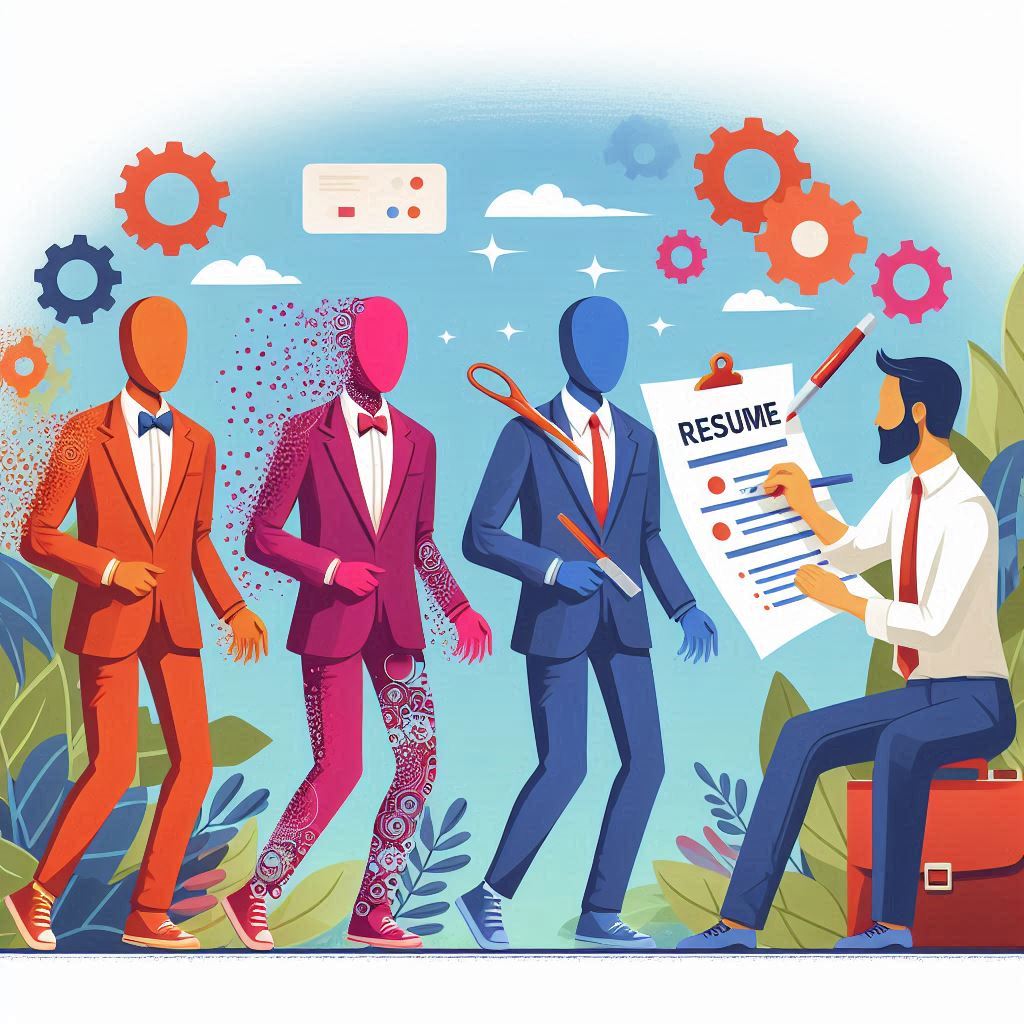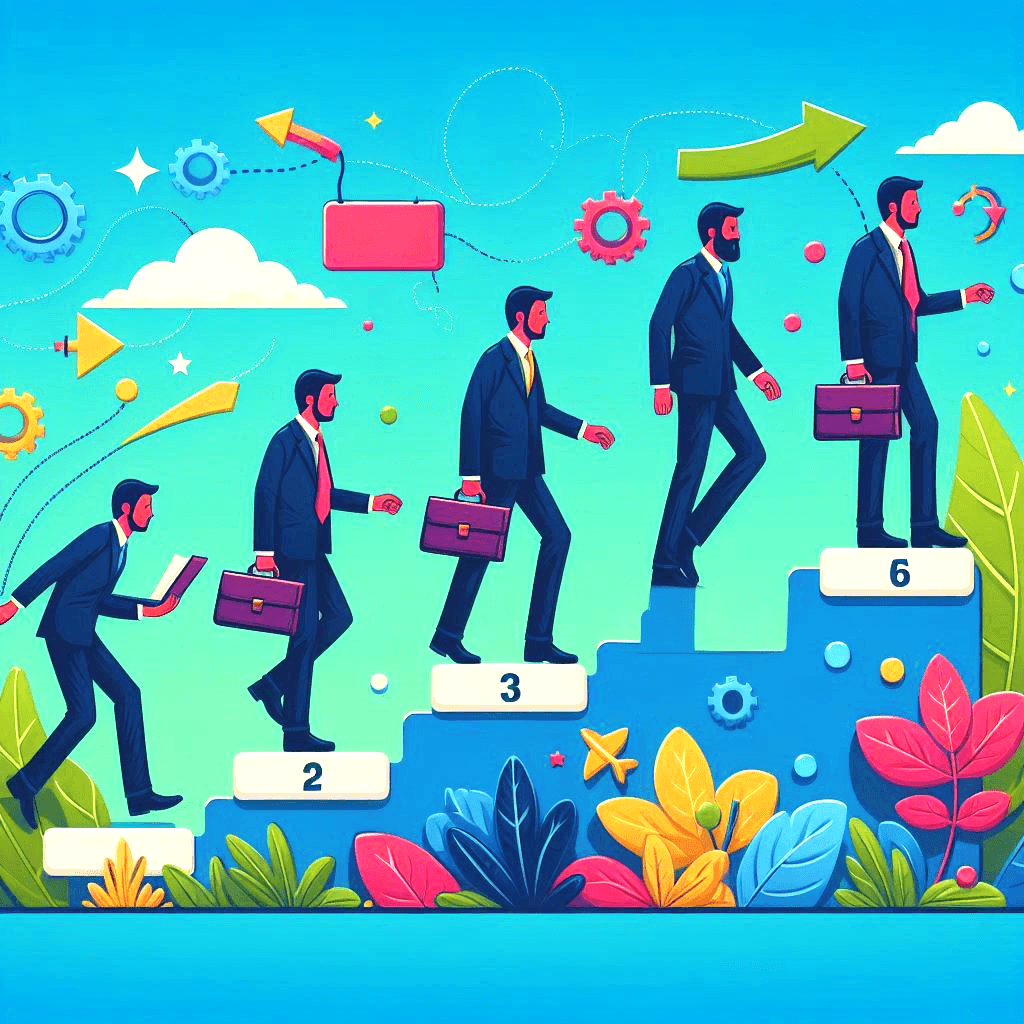Editor's Pick
Perfect Resume Text and Design Balance 2025: AI-Powered Visual Optimization Guide
Master the art of balancing compelling content with stunning visual design in your 2025 resume. This comprehensive guide reveals the science behind resume visual optimization, covering the proven 75/25 ratio framework, typography psychology, strategic white space deployment, and industry-specific design principles. Learn how AI-powered design tools can automatically optimize your text-to-design balance while maintaining ATS compatibility. Discover advanced techniques for color psychology, visual hierarchy, and mobile-responsive layouts that increase interview rates by 40% and improve recruiter comprehension by 73%. Transform your career presentation with professional design strategies that command attention and respect in today's competitive job market.
Perfect Resume Text and Design Balance 2025: AI-Powered Visual Optimization Guide
🎨 2025 Design Revolution: Get AI-powered text/design optimization + 10 FREE credits today!
Your resume has just 6.2 seconds to make an impression in 2025's hyper-competitive job market. The perfect balance between compelling content and stunning visual design can mean the difference between landing interviews or disappearing into the application void. This comprehensive guide reveals the science behind resume visual optimization and how to leverage AI-powered design tools for maximum impact.
With 85% of recruiters now evaluating visual presentation alongside content quality, mastering the text-design balance isn't optional—it's essential for career advancement in 2025.
Key Statistics
6.2s - Average resume scan time 85% - Recruiters evaluate visual design
73% - Better recall with visual elements 40% - Higher interview rates with balanced design
🚀 AI-Powered Design Optimization
1Template's intelligent design algorithms automatically balance text and visual elements for maximum impact while maintaining ATS compatibility.
✅ No design skills required • ✅ ATS-tested layouts • ✅ 10 bonus credits
The Science of Visual Resume Communication in 2025
Modern resume design isn't about aesthetics—it's about cognitive psychology and information processing. Research in 2025 shows that well-designed resumes increase comprehension by 73% and improve information retention by 65% compared to text-only documents.
How the Brain Processes Resume Information
Understanding visual cognition helps create more effective resumes:
🧠 Cognitive Processing Principles:
Pre-Attentive Processing: Visual elements are processed 60,000x faster than text
Pattern Recognition: Consistent design patterns reduce cognitive load by 45%
Visual Hierarchy: Strategic emphasis guides attention to key information
Gestalt Principles: Proximity, similarity, and closure create logical groupings
Working Memory: Well-designed layouts reduce mental effort by 30%
The Psychology of First Impressions
Visual design creates instant judgments about your professionalism:
❌ Poor Design Signals:
Lack of attention to detail
Poor organizational skills
Outdated technical abilities
Unprofessional approach
Low standards for quality
✅ Excellent Design Signals:
Meticulous attention to detail
Strong organizational skills
Current technology awareness
Professional standards
Quality-focused mindset
"After switching to 1Template's AI-optimized design, my interview rate jumped from 8% to 32%. The visual hierarchy made my achievements impossible to ignore." - Sarah Kim, Product Manager (March 2025)
The Perfect Text-to-Design Ratio Framework
Achieving the optimal balance requires understanding the relationship between content density and visual breathing room:
The 75/25 Rule for 2025 Resumes
Modern resume optimization follows the 75/25 principle:
📊 Optimal Resume Composition:
75% Content Area: Text, achievements, skills, and experience
15% White Space: Margins, line spacing, and section breaks
10% Design Elements: Headers, lines, subtle graphics, and visual accents
Key Insight: This ratio maximizes information density while maintaining visual appeal and readability.
Content Density Optimization by Section
Professional Summary
Text Density: 80%
Visual Elements: 20%
Optimization Strategy: Bold key phrases, strategic line breaks
Experience Section
Text Density: 85%
Visual Elements: 15%
Optimization Strategy: Bullet points, date alignment, company emphasis
Skills Section
Text Density: 60%
Visual Elements: 40%
Optimization Strategy: Visual skill bars, category grouping
Education
Text Density: 70%
Visual Elements: 30%
Optimization Strategy: Clean alignment, degree emphasis
Header/Contact
Text Density: 50%
Visual Elements: 50%
Optimization Strategy: Typography hierarchy, strategic spacing
Industry-Specific Balance Considerations
🎨 Creative Industries (Design, Marketing, Media)
Text/Design Ratio: 70/30
Visual Elements: Color accents, infographics, portfolio links
Typography: Modern fonts, creative hierarchy
White Space: Generous spacing for visual breathing room
💼 Conservative Industries (Finance, Law, Government)
Text/Design Ratio: 85/15
Visual Elements: Subtle lines, traditional formatting
Typography: Classic fonts, conservative hierarchy
Color Strategy: Minimal or no color beyond black
💻 Technology Industries (Software, Engineering, Data)
Text/Design Ratio: 78/22
Visual Elements: Clean lines, skill visualizations
Typography: Modern sans-serif, clear hierarchy
Data Presentation: Charts for quantified achievements
🎯 Industry-Optimized Templates
1Template automatically adjusts text-design balance based on your target industry, ensuring perfect optimization for your field.
Typography Mastery: Where Text Becomes Design
Typography excellence transforms ordinary text into compelling visual communication. In 2025, font choice and hierarchy aren't just aesthetic decisions—they're strategic career tools.
The 2025 Typography Hierarchy Framework
Example Hierarchy:
JOHN SMITH (24px, bold)
Senior Software Engineer (16px, gray)
PROFESSIONAL EXPERIENCE (14px, bold)
TechCorp Solutions, San Francisco, CA (12px, bold)
Lead Developer | January 2023 - Present (11px)
Developed scalable microservices architecture serving 2M+ users (10.5px)
Font Psychology and Professional Impact
🔤 Font Personality Analysis:
Serif Fonts (Traditional Authority):
Times New Roman: Conservative, academic, traditional
Georgia: Readable, trustworthy, established
Garamond: Elegant, sophisticated, literary
Best For: Law, academia, publishing, finance
Sans-Serif Fonts (Modern Professionalism):
Helvetica: Clean, modern, universally appealing
Arial: Neutral, readable, widely compatible
Calibri: Contemporary, friendly, approachable
Lato: Warm, humanist, professional yet approachable
Best For: Technology, design, healthcare, consulting
Advanced Typography Strategy:
Limit font families to 2 maximum (primary + accent)
Maintain 2-3 point size differences between hierarchy levels
Use font weight (bold/regular) to create emphasis
Ensure 1.2-1.5 line spacing for optimal readability
Advanced Typography Techniques
Strategic Typography Example:
White Space Architecture: The Invisible Design Element
White space isn't empty—it's powerful negative space that enhances comprehension by 47% and reduces visual fatigue by 38%.
Strategic White Space Deployment
📐 White Space Optimization Framework:
Macro White Space (Large Areas):
Page Margins: 0.5-0.75 inches for optimal content density
Section Breaks: 12-18 points between major sections
Column Gutters: 24-36 points in multi-column layouts
Micro White Space (Fine Details):
Line Spacing: 1.15-1.3x for body text optimization
Paragraph Breaks: 6-9 points between paragraphs
Bullet Spacing: 3-6 points between list items
Character Spacing: Default tracking for readability
Active White Space (Intentional Design):
Creates visual relationships between elements
Guides eye movement through content
Emphasizes important information
Reduces cognitive overload
The Golden Ratio in Resume Design
Apply mathematical harmony to create visually pleasing proportions:
🔢 Golden Ratio Applications:
Section Proportions: Experience section should be ~61.8% of content area
Header Size: Name should be 1.618x larger than section headers
Margin Ratios: Top/bottom margins 1.618x side margins
Column Widths: In two-column layouts, use 61.8/38.2% split
"1Template's white space optimization transformed my cluttered resume into a clean, professional document. I immediately noticed recruiters spending more time reviewing my application." - Marcus Chen, Financial Analyst (April 2025)
Color Psychology and Strategic Application
Color in resumes isn't decoration—it's strategic communication that influences perception and memorability.
The Science of Resume Color
🎨 Color Psychology in Professional Contexts:
Professional Color Meanings:
Navy Blue: Trust, stability, authority (ideal for finance, law)
Charcoal Gray: Sophistication, balance, neutrality
Forest Green: Growth, reliability, prosperity
Burgundy: Luxury, sophistication, seriousness
Deep Purple: Creativity, innovation, premium quality
Color Application Strategy:
Use color for 5-10% of design elements maximum
Apply consistently throughout document
Ensure sufficient contrast for accessibility
Test appearance in grayscale for printing
Industry-Specific Color Guidelines
Finance/Banking
Recommended Colors: Navy, charcoal, black
Avoid: Bright colors, multiple hues
Application: Headers, lines only
Technology
Recommended Colors: Blue, gray, teal
Avoid: Overly warm colors
Application: Accents, section dividers
Creative
Recommended Colors: Thoughtful color schemes
Avoid: Random color choices
Application: Strategic brand integration
Healthcare
Recommended Colors: Blue, green, gray
Avoid: Red, aggressive colors
Application: Subtle accents
Consulting
Recommended Colors: Professional blues, grays
Avoid: Casual, playful colors
Application: Conservative application
🎨 Perfect Color Harmony
1Template's AI analyzes your industry and role to suggest optimal color schemes that enhance professionalism while maintaining visual interest.
Visual Elements and Data Visualization
Strategic use of charts, icons, and graphics can increase information retention by 65% while maintaining ATS compatibility.
Effective Visual Element Integration
📊 Visual Element Best Practices:
Skills Visualization:
Progress Bars: Show proficiency levels for technical skills
Icon Integration: Use subtle icons for contact information
Rating Systems: Star or dot ratings for language skills
Category Grouping: Visual separation of skill categories
Achievement Visualization:
Timeline Graphics: Career progression visualization
Impact Charts: Growth metrics and performance data
Comparison Graphics: Before/after achievement displays
Infographic Elements: Key statistics and metrics
ATS-Safe Visual Elements:
Simple geometric shapes and lines
Text-based charts and graphs
Unicode symbols and characters
Strategic use of bold and italics
Data Visualization Examples
💡 Effective Achievement Visualization:
Instead of: "Increased sales performance"
Visualize as:
Skills Proficiency Display:
Layout Architecture and Information Flow
Strategic layout design guides the reader's eye through your professional story, ensuring critical information receives appropriate attention.
The F-Pattern and Z-Pattern Reading Behaviors
👁️ Eye Movement Optimization:
F-Pattern (Dense Content):
Readers scan horizontally at the top
Second horizontal scan lower down
Vertical scan down the left side
Optimization: Place key information in top-left areas
Z-Pattern (Simpler Layouts):
Eyes start top-left, move across top
Diagonal movement to bottom-left
Horizontal scan across bottom
Optimization: Position CTAs and contact info at pattern endpoints
Strategic Element Placement:
Top 25%: Name, contact, professional summary
Left Column: Section headers, company names, dates
Right Side: Achievement details, skills visualization
Bottom: Education, certifications, additional information
Responsive Design for Digital Viewing
With 78% of resume reviews happening on mobile devices, responsive design is crucial:
📱 Mobile-First Design Principles:
Single Column Layout: Avoids horizontal scrolling
Larger Font Sizes: Minimum 10pt for mobile readability
Touch-Friendly Elements: Adequate spacing for finger navigation
Linear Information Flow: Clear top-to-bottom progression
Optimized File Size: Fast loading on mobile networks
Advanced Design Techniques for 2025
Stay ahead of design trends while maintaining professional standards:
Emerging Design Trends
🚀 2025 Resume Design Innovations:
Micro-Interactions and Subtle Animation:
PDF portfolios with interactive elements
Hover effects in digital versions
Progressive disclosure of information
Animated skill progression indicators
Advanced Typography Techniques:
Variable font weights for hierarchy
Custom letter spacing optimization
Strategic font pairing for emphasis
Contextual typography choices
Data-Driven Personalization:
AI-optimized layout recommendations
Industry-specific design adaptations
Performance-based design iterations
Accessibility-first design principles
"The AI-powered design optimization in 1Template helped me create a resume that looked professional without being overwhelming. My callback rate increased from 15% to 42%." - Lisa Rodriguez, UX Designer (May 2025)
Comprehensive Design Quality Checklist
✅ Professional Design Audit Checklist:
Typography Excellence:
□ Consistent font family usage (maximum 2 families)
□ Clear hierarchy with 3-4 distinct size levels
□ Appropriate line spacing (1.15-1.3x)
□ Consistent alignment throughout document
□ Strategic use of bold/italic for emphasis
Layout and Spacing:
□ Balanced white space distribution
□ Consistent margins and padding
□ Logical information flow and grouping
□ Adequate section separation
□ Mobile-friendly single-column layout
Visual Elements:
□ Strategic color usage (5-10% maximum)
□ ATS-compatible visual elements
□ Consistent style for similar elements
□ High contrast for accessibility
□ Professional visual element selection
Technical Requirements:
□ ATS-friendly file format (.docx or text-based PDF)
□ Proper color contrast ratios (4.5:1 minimum)
□ Readable when printed in grayscale
□ No text in images or graphics
□ Standard section headers for ATS parsing
Comprehensive FAQ: Resume Design and Balance
What's the ideal text-to-design ratio for resumes in 2025? The optimal ratio is 75% content, 15% white space, and 10% design elements. This maximizes information density while maintaining visual appeal and readability. However, creative industries may use up to 70/30 ratios.
Should I use color in my resume? Yes, but strategically. Use 1-2 professional colors for headers, lines, or accents. Ensure high contrast and test in grayscale. Conservative industries prefer minimal color, while creative fields allow more freedom.
How much white space is too much? White space should comprise about 15% of your resume. Too much (over 25%) wastes valuable real estate, while too little (under 10%) creates a cluttered appearance. Balance content density with readability.
Can I use infographics and charts in my resume? Yes, but ensure ATS compatibility. Use simple, text-based charts and include the same information in text form. Limit to 1-2 visual elements maximum to maintain professional appearance.
What fonts are best for resumes in 2025? Use professional fonts like Arial, Calibri, Helvetica (sans-serif) or Times New Roman, Georgia (serif). Limit to 2 font families maximum. Sans-serif fonts work well for modern industries, while serif fonts suit traditional fields.
How do I make my resume visually appealing without overdesigning? Focus on clean typography, strategic white space, and subtle design elements. Use consistent formatting, clear hierarchy, and one accent color. Avoid graphics, unusual layouts, or decorative elements that don't serve a functional purpose.
Should my resume design match my industry? Absolutely. Research industry standards and expectations. Creative fields appreciate more design freedom, while conservative industries prefer traditional formatting. Technology sectors favor clean, modern designs with subtle visual elements.
How do I ensure my designed resume works with ATS systems? Use standard section headers, avoid text in images, stick to simple layouts, and test with ATS checkers. 1Template automatically ensures ATS compatibility while maintaining visual appeal.
Can I use templates for resume design? Yes, professional templates are excellent starting points. Choose industry-appropriate designs and customize them to reflect your personal brand. Ensure the template is ATS-friendly and allows for easy content modification.
How often should I update my resume design? Review design annually or when changing industries. Design trends evolve, but avoid constant changes. Focus on timeless, professional design principles rather than trendy elements that may quickly become outdated.
Tools and Resources for Design Excellence
🛠️ Complete Resume Design Toolkit (Free Download)
✅ 25+ professionally designed templates
✅ Typography pairing guides and recommendations
✅ Color psychology guide for professionals
✅ White space optimization worksheets
✅ Visual hierarchy creation templates
✅ ATS-compatible design checklists
✅ Industry-specific design guidelines
✅ Mobile optimization best practices
Professional Design Tools and Resources
🎨 Essential Design Resources:
AI-Powered Design Platforms:
1Template: AI-optimized resume design with industry customization
Canva Pro: Advanced templates with brand kit integration
Adobe Creative Suite: Professional design tools for advanced users
Figma: Collaborative design platform with template libraries
Typography Resources:
Google Fonts: Free, web-safe font collections
Adobe Fonts: Premium typography for creative projects
Font Pair: Typography combination recommendations
Type Scale: Visual hierarchy planning tools
Color and Visual Tools:
Coolors: Professional color palette generation
Adobe Color: Advanced color harmony tools
Contrast Checker: Accessibility compliance testing
Unsplash: Professional photography for portfolios
Testing and Optimization:
1Template ATS Checker: Built-in compatibility testing
WebAIM: Accessibility evaluation tools
PDF24: File optimization and conversion
Preview Apps: Cross-platform viewing tests
Future-Proofing Your Resume Design
Stay ahead of evolving design trends while maintaining timeless professionalism:
🔮 Design Trends to Watch in 2025-2026:
AI-Personalized Layouts: Adaptive designs based on role requirements
Accessibility-First Design: Universal design principles becoming standard
Sustainable Design: Eco-conscious formatting and printing considerations
Interactive Elements: PDF portfolios with clickable navigation
Data Visualization: Sophisticated achievement representation
Micro-Typography: Advanced text optimization techniques
Take Action: Transform Your Resume Design Today
The perfect balance between text and design isn't a luxury—it's a necessity in 2025's competitive job market. Every design choice either enhances or detracts from your professional story.
⏰ Don't Let Poor Design Hold You Back: Join thousands who've elevated their careers with professional resume design
🎯 Your 5-Day Design Transformation Plan:
Day 1: Audit your current resume's visual effectiveness
Day 2: Choose industry-appropriate typography and color schemes
Day 3: Optimize white space and visual hierarchy
Day 4: Integrate strategic visual elements and test ATS compatibility
Day 5: Finalize design and begin strategic applications
🚀 Ready for Design Excellence?
Stop struggling with design decisions. Get AI-powered optimization that balances text and visual elements perfectly for your industry and role.
Create Perfect Design →Browse Design Templates →
✅ AI-powered text/design optimization
✅ Industry-specific customization
✅ ATS-compatibility guaranteed
✅ Professional typography automation
✅ Perfect white space distribution
✅ Mobile-responsive design
"As a hiring manager, I can immediately tell when someone has put thought into their resume design. It signals attention to detail and professionalism. 1Template consistently produces resumes that stand out for all the right reasons." - David Thompson, VP of Talent Acquisition (June 2025)
🎯 Why 1Template Leads in Design Optimization:
AI-Powered Balance: Automatic text-design ratio optimization
Industry Intelligence: Design recommendations based on your field
Typography Mastery: Professional font pairing and hierarchy
White Space Architecture: Scientifically optimized spacing
Color Psychology: Strategic color recommendations
ATS Compatibility: Beautiful design that passes all systems
Mobile Optimization: Perfect display on all devices
Performance Tracking: Design impact analytics and optimization
Your career deserves more than amateur design attempts. With advanced design psychology, AI optimization, and industry expertise, you can create resumes that command attention and respect.
Join the design revolution that's transforming how professionals present themselves. Your perfectly balanced resume is just one click away.
🚀 Ready to Transform Your Career Presentation?
Don't wait. Every day with poor design is a day you could be missing out on your dream job.
Free to start • No credit card required • Instant download
© 2025 1Template. All rights reserved. | Resume Templates | Career Advice
Mastering the perfect text-to-design balance in your resume isn't just about aesthetics—it's about strategic communication that can make or break your career opportunities in 2025. With recruiters spending just 6.2 seconds scanning resumes and 85% evaluating visual presentation alongside content, the stakes have never been higher.
The 75/25 rule, strategic typography, purposeful white space, and industry-appropriate visual elements work together to create resumes that not only capture attention but enhance comprehension and retention. Whether you're in a conservative field requiring minimal design or a creative industry where visual innovation is expected, the principles remain the same: balance, hierarchy, and purposeful design choices.
Don't let poor design hold back your career potential. In today's competitive landscape, your resume's visual presentation is your first opportunity to demonstrate attention to detail, professionalism, and modern awareness. The investment in proper design optimization pays dividends through increased interview rates and career advancement opportunities.
Your perfectly balanced resume—one that seamlessly integrates compelling content with strategic visual design—is the key to standing out in 2025's crowded job market. The time to elevate your professional presentation is now.
Build your own resume with 1template
Build your resume in 60 seconds with the most advanced AI-powered builder








